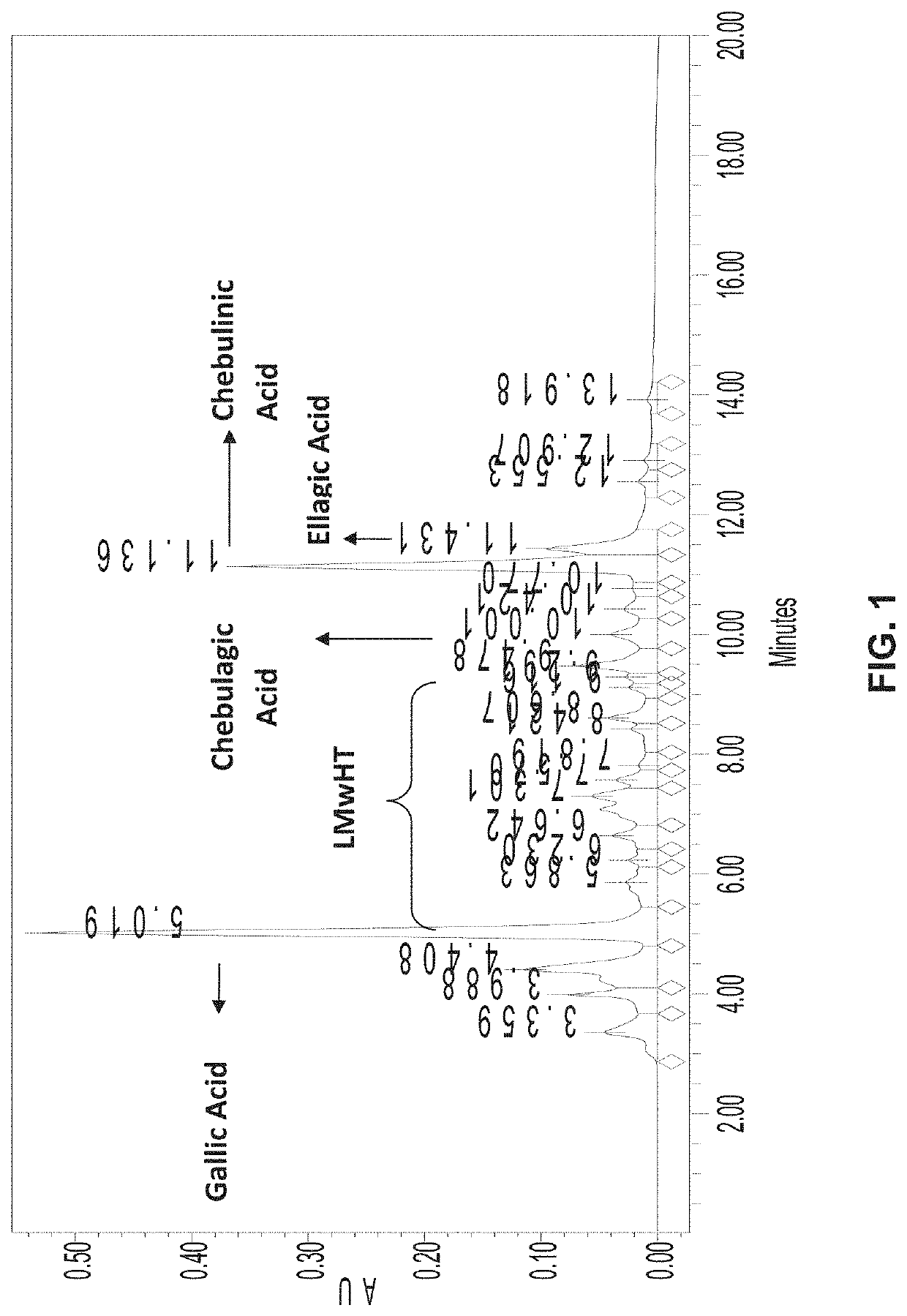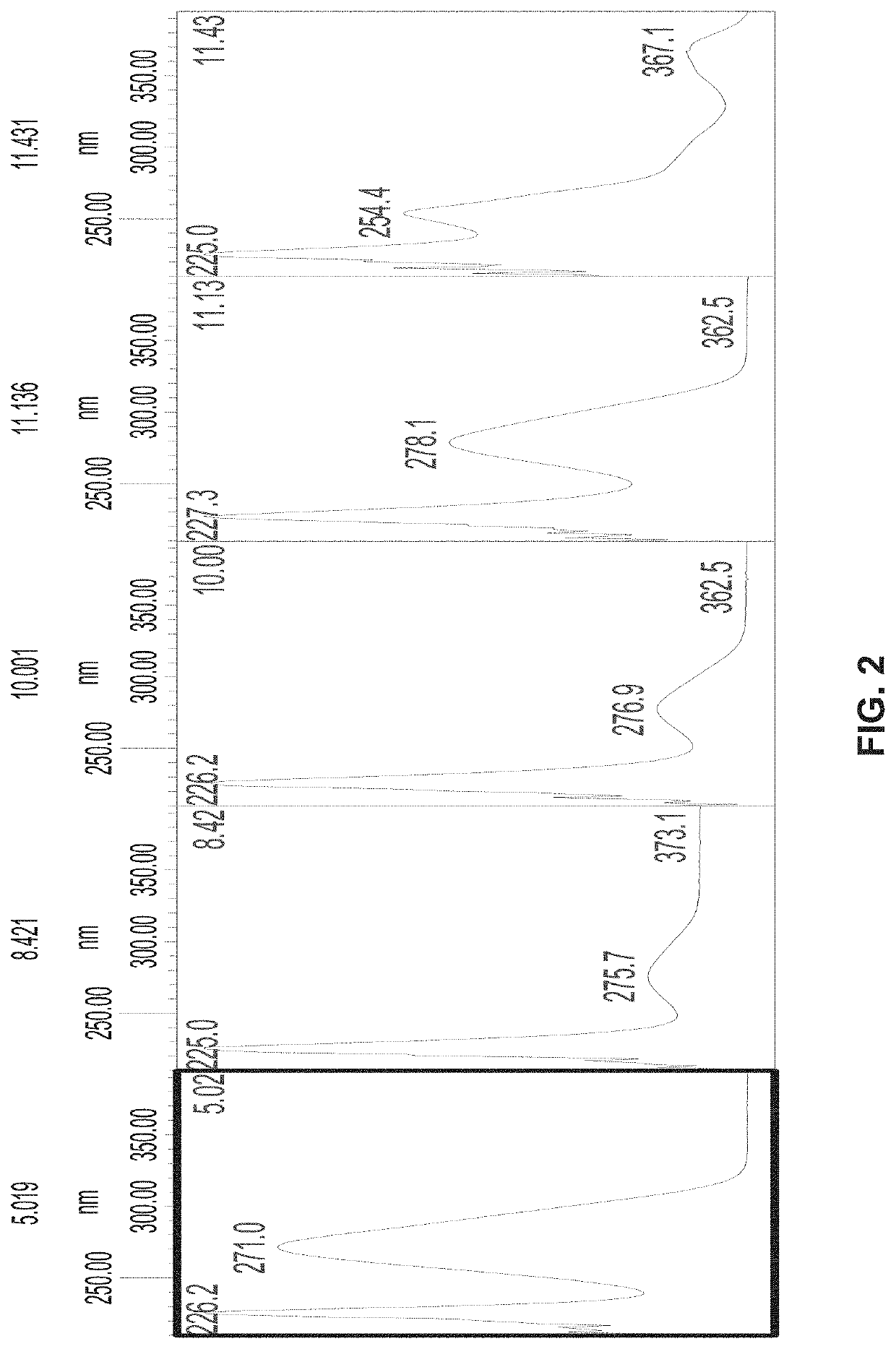Methods for relieving back pain with terminalia chebula compositions
a technology of compositions and terminal chebula, which is applied in the field of relieving back pain with terminal chebula compositions, can solve the problems of chronic pain, self-limiting back pain, and radiation into the arms and hands
- Summary
- Abstract
- Description
- Claims
- Application Information
AI Technical Summary
Benefits of technology
Problems solved by technology
Method used
Image
Examples
example 1
Assays
Analytical Methodology
[0105]Standardized aqueous extracts of T. chebula fruit (AyuFlex®) were and are analyzed to identify and confirm amounts of active components chebulinic acid, chebulagic acid, other LMwHTs, gallic acid, and ellagic acid. In this Example, chebulinic acid, chebulagic acid, and other LMwHTs in the extract are analyzed by HPLC (High Pressure Liquid Chromatography) and HPLC-PDA and quantified by using the calibration curve of an external chebulinic acid standard. See for instance FIGS. 1 and 2. Gallic acid and Ellagic acid are analyzed by HPLC and quantified by using a calibration curve of, respectively, Gallic acid and Ellagic acid. This Example displays typical analytical methods, results, and expected standards for AyuFlex®.
Analysis
[0106]T. chebula powdered aqueous extract (AyuFlex®) (50 mg) was dissolved in Milli-Q® water (50 ml) by shaking for 5 minutes. The resulting solution had a concentration of 1 mg / ml. It was diluted with Milli-Q® ...
examples 2-5
[0133]Several human subjects suffering from back pain were administered an effective amount of a T. chebula composition according to the present invention (AyuFlex®, an aqueous extract of T. chebula fruit in powdered and standardized form, orally administered in a capsule containing 500 mg of the extract). Each subject reported that the T. chebula composition relieved back pain, as discussed in Examples 2-5. Subject weights ranged from 54.5 kg to 72.7 kg, and daily doses ranged from 500 mg to 2000 mg per day of AyuFlex®, which may be calculated at a dose range of about 6.88 mg AyuFlex® / kg body weight of a subject to about 36.7 mg AyuFlex® / kg body weight of a subject. Each of the below Examples shows successful treatment of back pain with T. chebula compositions of this invention, with such treatment resulting in significant relief from back pain, for instance by reducing or eliminating back pain.
example 2
[0134]A subject according to this invention, an adult man, 27 years of age and weighing about 145 pounds, reported that AyuFlex® administration relieved his low back pain.
[0135]Prior to administration of AyuFlex®, the subject reported a history of suffering from chronic low back pain, described by the subject as sciatic pain, as well as from patellar tendonitis, for the past ten years. The subject indicated his belief that the low back pain was due to a very active lifestyle that included lifting heavy weights. He previously attempted to relieve the chronic low back pain with numerous rounds of physical therapy and rehab-based regimens, but was only provided with temporary relief until he resumed exercise.
[0136]The subject began oral administration of 2 (two) 500 mg AyuFlex® capsules daily to treat his low back pain. The subject continued the daily administration of AyuFlex® for 2-3 months, and reported his low back and knees were far less inflamed and painful than before he began a...
PUM
 Login to View More
Login to View More Abstract
Description
Claims
Application Information
 Login to View More
Login to View More - R&D
- Intellectual Property
- Life Sciences
- Materials
- Tech Scout
- Unparalleled Data Quality
- Higher Quality Content
- 60% Fewer Hallucinations
Browse by: Latest US Patents, China's latest patents, Technical Efficacy Thesaurus, Application Domain, Technology Topic, Popular Technical Reports.
© 2025 PatSnap. All rights reserved.Legal|Privacy policy|Modern Slavery Act Transparency Statement|Sitemap|About US| Contact US: help@patsnap.com


